
| Volume 30 #5 | March/April 2014 | |

I'm ready for Spring! Don't get me wrong, I really like the winters here in the Northwest; I love the rain, fog, drizzle, clouds, the snow, and even the wind -- sometimes. But when these elements combine to prevent attendence at dance classes and events -- as has happened more than once in the past few weeks -- it's just time to get a new Season.
However: I checked our Bylaws. Management of Seasons and weather is not mentioned anywhere as goals or duties of the Branch. So, I guess we just have to wait.
Our branch recently performed some dancing at the Rose Schnitzer retirement home, to a very appreciative audience. It was fun for us, and they enjoyed it very much. They enjoyed it so much, they've asked us back again! Plus, they told other retirement homes about how much they enjoyed it, and we now have several dancing opportunities coming up on or around St. Patrick's Day. It's a lot of fun to do, the dances are simple, and I heartily recommend you give it a try. Talk to your teacher, or email Geri Stuart to get connected.
Our Annual Dinner Dance is coming up on April 26th. As if in answer to the wild and wooly winter we've had, this year's theme of Blue Hawaii soooo appropriately addresses our need for rebirth and renewal, promising fine days and tranquil nights of dancing, and still crisp enough we can dress Scottish! Be sure to get your reservations in before the deadline of April 6th!
And finally, I mention that Linda Mae's Friday night class has moved. The new class is held at the Fairview Community Center, in Fairview, OR. This is a lot closer to the Portland/Vancouver metro area, so if you live "in town" and have ever wanted to check out her Friday night class, this could be your opportunity.
Happy dancing, All!
Five years ago we became an official branch of the RSCDS. Before long SW Washington State Branch earned non-profit status at the federal and state levels. It makes this treasurer proud that individuals and businesses can claim donations to our branch as tax deductions. In fact, at the end of the year I send out a letter acknowledging donations from individuals or businesses totaling $300 or more. By the way, I can also send a letter to anyone who wants a record of donations to send in with their IRS tax form.
But why would someone want to make annual or monthly donations to our local branch?
Sometimes, a specific need inspires someone to make a gift. The first dinner dance we had five years ago at the Fairgate Inn in Camas was our 'coming out party' and we went all out. The venue was gorgeous, the food was delicious, and the musicians were top rate (Lisa Scott and Elke Baker). A generous donation helped fill the gap between the price of admission and the costs. That donation made that event possible and kept our fledgling branch solvent. Recently, donations made it possible for us to buy a banner with our new branch name on it. We fell in love with the large, tall banner at last year's summer picnic and it was a big hit at the Highland Games.
Giving to a local organization is another reason for donations. There are no overhead costs, so all the money donated actually goes to the organization. Extra dollars help us put on dances with live music, assist teachers with a few costs like architect’s eraser crumbs to prevent slipping on the floor, and encourage us to dream up new ideas to enhance our dancing. Unlike giving to a large national or international organization to support an idea, local giving helps the donor experience the effects of his gift first hand.
The other reason to donate to our local branch is LOVE. Donors want this branch to continue to thrive. They want to put their dollars where their hearts are and where the joy of dancing is felt.
Donations are always welcome and always remain anonymous. Only your treasurer knows.
This is an update of a newsletter item I wrote 18 months ago, "SCD Branch Goals and Methods". http://www.rscds-swws.org/news/201209/vol29-2.htm#GoalsMethods I had been exploring what are the activities of the Branch and why its members choose to pursue the activities. When I joined the Management Board as the Treasurer in 2012, I made a list of existing methods that the Branch performs, and captured new ideas, http://www.rscds-swws.org/doc/BranchGoalsMethodsIdeas.pdf. I have explored several new ideas and shared with members. Some of the ideas were accepted, some were ignored, and some ideas got folks agitated. I have had fun developing my curiosity by asking questions and making connections and imagining exciting possibilities. I enjoyed learning how the human brain functions in this context.
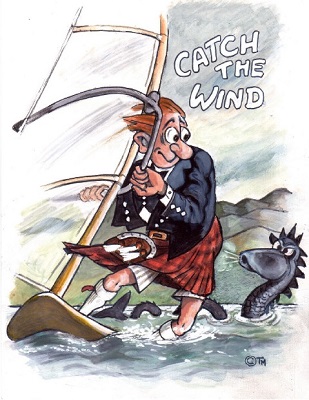
Successful Branch operation depends on two qualities:
We are pretty strong on positive energy. Curiosity is a more challenging emotion, and requires practice to develop the skill. I read about curiosity in Emotional Equations by Chip Conley (http://emotionalequations.com/.) Following are key points. Curiosity is one of the Four Cs (curiosity, confidence, courage, constancy) that Walt Disney, Albert Einstein, and Sony founder Akio Morita valued to make dreams come true. Curiosity fuels creativity, and enables us to become open to learning options. Warning: curiosity requires admitting you don't know what you don't know. Without curiosity, we avoid asking questions for fear of finding answers that threaten our beliefs and status quo, compared with facing the big questions with a curious heart and mind. We can develop our mind-set for how to deal with failure; Fixed: dread failure, consider a negative reflection of our abilities, unwilling to risk being curious or risk-taking; compared with Growth: we see failure as a constructive path toward improvement. Make curiosity a habit. Ask questions, become open to bigger questions.
I reviewed the original Branch Methods list from July 2012, and listed the topics I have explored, http://www.rscds-swws.org/doc/BranchGoalsMethodsIdeas-Tom.pdf. Once I got going, I was able to think of so many ideas that fear of failure was less of a concern.
I began sharing Goals and Methods with the Management Board and I observed the topic was initially given a low priority compared with the usual transactional topics. I wrote a Goals and Methods Process document that covers guidelines for a standing Goals and Methods Committee that would discuss transformational topics, http://www.rscds-swws.org/doc/BranchGoalsMethodsProcess.doc.
The Management Board met in November 2013 for the first Goals and Methods retreat. I practiced facilitation skills in order to encourage members to build on each other's ideas. The committee chair leads more on process and less on content. The main result was an initial Branch "To-Be List" vision of the Branch for the next three years, http://www.rscds-swws.org/doc/BranchToBeList.pdf. The next step is to prioritize the goals and identify the methods we would like to use in order to accomplish the goals.
I organized the list of Branch methods of our volunteer organization according to components of officers and committees, and wrote a document whose audience is Management Board and Dance Teachers and Branch Members. The goals of the document are: provide training information for members who operate the Branch processes, and provide the ability to discuss opportunities for process agreement and improvement. Each component lists “interface methods” that are visible by others, http://www.rscds-swws.org/doc/BranchMethods.doc. I shared the document with partners and tested the methods for accuracy. I wrote a Branch Treasurer Methods document, with detailed information how to perform the methods. The new Treasurer this year can refer to the document in order to perform the Treasurer processes. As the Branch Secretary this year, I wrote a Branch Secretary Methods document, with similar detailed methods information.
I have enjoyed exploring Branch goals and methods and learning things and asking questions. I look forward to collaborating with friends to develop the Branch methods of the To-Be List and imagine exciting new projects that would attract more Branch members who want to participate in the planning.
Eight Vancouver/Portland dancers performed at the Rose Schnitzer Manor assisted living facility in west Portland on February 16th. Event leader, Liza, was joined by fellow dancers Tom, Susan, John, Martin, Marge, Geri, and Robert. Two of these folks hadn’t even been able to attend rehearsal, and yet everyone performed admirably.
The performance room was spacious, carpeted, and wood-paneled. The audience was appreciative, and already wants us back again. Three audience members joined our performance – Mary and Shelly (in his motorized wheelchair) for a dance, and Hy at the end for some tunes on his fiddle. It was an enjoyable event for all of us. In the midst of The Rose Schnitzer Manor, a Jewish retirement home with all the cultural and religious symbology one would expect, Hy, who plays Scottish fiddle, and Shelly who has been to the Edinburgh Tattoo twice and courageously participated with us, reminded me yet again that if Scotland were wiped off the face of the earth tomorrow, we would still know she existed. ~ The Editor
Performances like this are low key. The event leader makes sure that the dancers are well-prepared and that the dances are simple and easy to learn. We brief the dances or walk through them as needed on the dance floor, and mistakes just add to the fun. We are always much appreciated by the audience. I would recommend to new and experienced dancers alike to say "Yes, I’d love to" the next time a performance request comes to your inbox. You'll be glad you did.
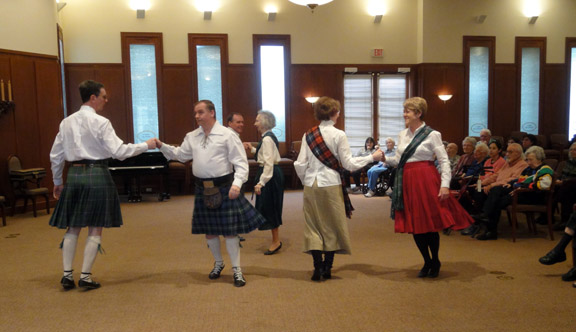
|
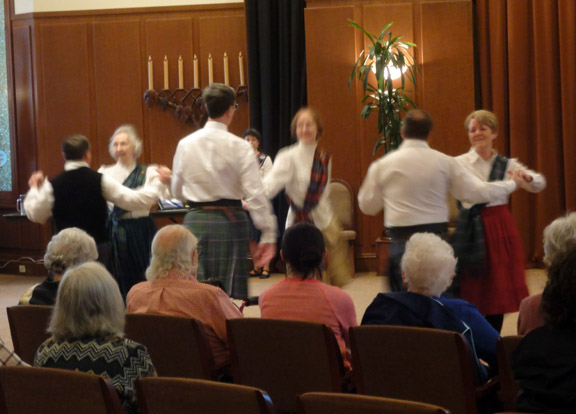
|
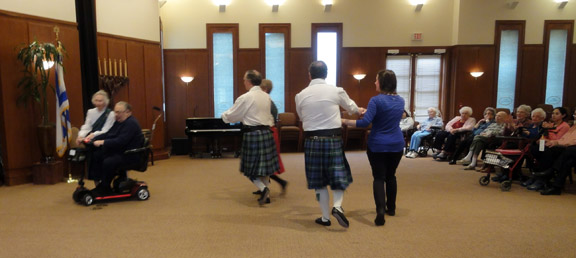
|
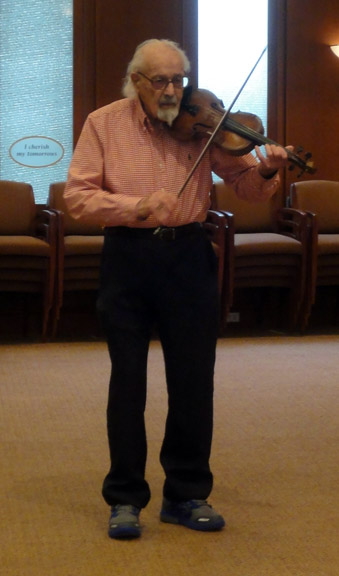
Recently, I came across an article written by Evelyn M.E. Murray I had saved from "The Family Tree" (Aug/Sept 1999) -- Yes, a genealogical newspaper! Her words are in quotes here.
"Some people have difficulties in coming to the Scottish style of presentation after being exposed to other styles" (e.g. International Folk, English Country Dance). "All teachers differ in the way they present their material."
"RSCDS teachers base their method of teaching on using steps and figures, then show how a particular dance is constructed from what is already known" She writes that we use "building blocks"-- meaning "building figures" of the dance.
"An International Teacher would present the dance as a complete whole, not broken down into its constituent figures, so that the dancers in this group memorize the dance by name."
Evelyn tells of putting the five couple dance Polharrow Burn on a program -- then goes on to say, "This dance is quite complicated, requiring SC Dancers to be comfortable with simple forms of five couple sets, half reels of four, and be able to cope with meanwhile figures. The International dancer will handle this dance without any major difficulty once they have learned the whole dance as an entity. However, they will not know how to dance a reel of four, whereas the Scottish dancer will immediately face the correct way and take off!"
"Obviously as an SCD teacher I defend the method of teaching by the building blocks of the figures and steps, as in the long run that produces a dancer who can cope with any dance."
And those who dance in the classes I teach know now why I (Marge) ascribe to the philosophy of The RSCDS Method, helping people learn 'dancing' as opposed to teaching 'dances.' However, I still do enjoy learning dances along with other Folk, English, or contra dancers!
Added note: Evelyn put Polharrow Burn as the "challenge" dance on a program of mainly "old favorites." (Evelyn has taught in Boston Branch for quite a long time.)
Here are lifetime statistics for the DancieMaetion dance animations on YouTube. The female viewers are catching up though it seems male viewers from the UK are the most studious. Perhaps they don't want to get laughed at by the ladies(?) We are receiving about 5,000 views a month.
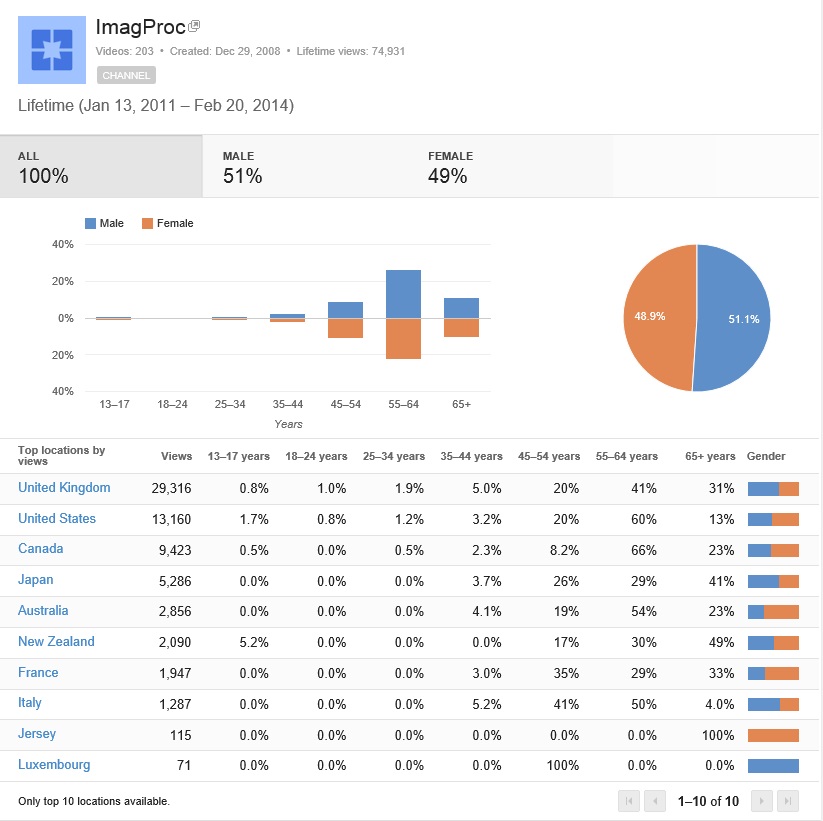
I began learning Square dance five years ago, after Scottish dancing for the previous twelve years. I began keeping a fun list of "Tom's Enlightened Dancer Friends who have danced both
Scottish dance and Square dance with Tom one time." We can access the latest version that currently has fifty five names over the past four years.
http://www.rscds-swws.org/doc/EnlightenedDancers.htm
This past year I expanded my interest to explore Irish Ceili dance, English Country dance, Contra dance, and International Folk dance. My son-in-law, Hans, invented the term "Dauntless Dancer." Since "dauntless" means "fearless",
and given my interest in additional dance forms, I thought of a new list of "Tom's Dauntless Dancer Friends who have danced any three folk dance forms with Tom one time, from a list of folk dance forms with
partners in a set." We can access the latest version that currently has nine names.
http://www.rscds-swws.org/doc/DauntlessDancers.htm
What is the value of trying another folk dance form? I have observed that practicing multiple dance forms provides more variety and interest, compared with a single folk dance form. The skills learned from one dance form carry over to another. Dance groups share common interests, and we can learn ideas from others, in the areas of enhancing social friendships, planning dance classes and events, and teaching. There are opportunities for dance groups to collaborate and support one another, as overall folk dance popularity declines in the United States. However we need ideas like this article in order to neutralize the tendency for a dancer to become entrenched in a single dance form as their experience increases, and they lose their curiosity to explore new folk dancing ideas. I have observed that the "Enlightened Dancers" and "Dauntless Dancers" lists are less likely to include the leaders of dance groups, and are more likely to include new dancers.
Please let me know when you want to try something new for two hours, and I will I look forward to dancing with you and adding you to my “Enlightened Dancers” and “Dauntless Dancers” lists.
RSCDS has introduced its new website at http://www.rscds.org/, with lots of information available to the public about Scottish country dancing. The website also contains members-only information. RSCDS members have received an email with the member login.
Remember, the RSCDS Branch member half year is available for $15, http://www.rscds-swws.org/membership.htm.

Some of you have heard about or participated in the Stevenson class for some time now and are aware of this change. For those of you who are not aware, see below the details of a change of venue for that class to the Fairview Community Center.
See you there!
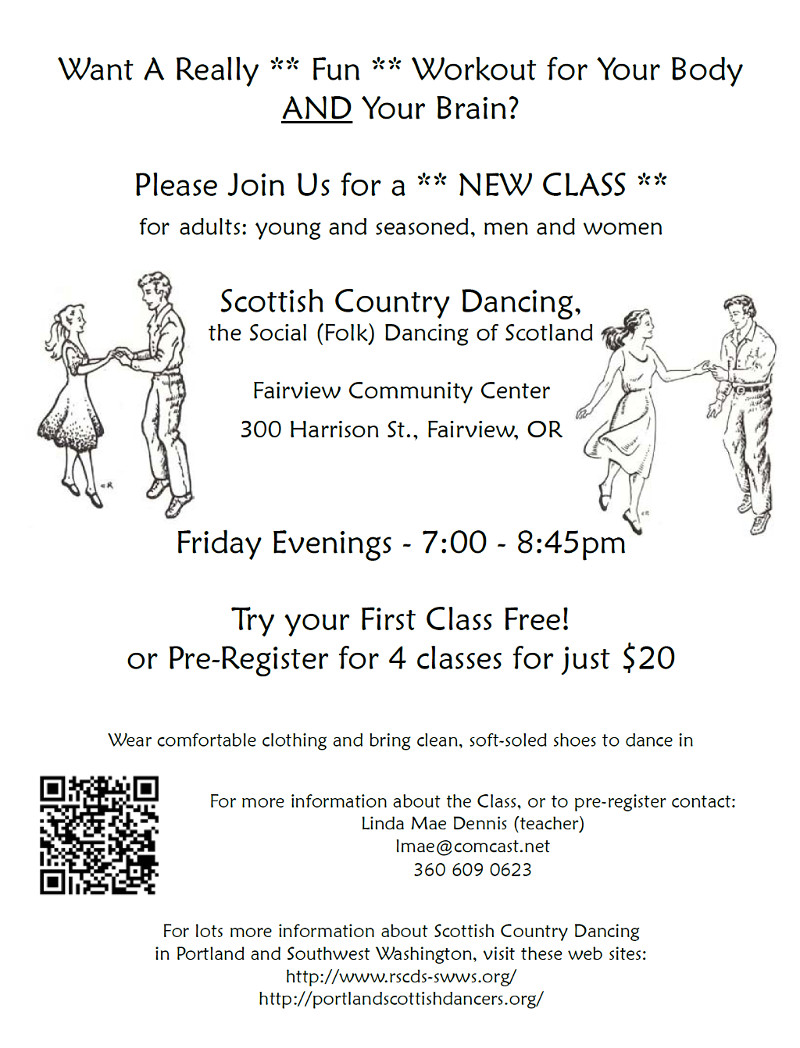
Calendar of Events | |||||||||||||||||||||||||||||||||||||||||||||||||||||||||||||||||||||||||||||||||||||||||||||||||||||||||||||||||||||||||||||||||||||||||||||||||||||||||||||||||||||||
|
|